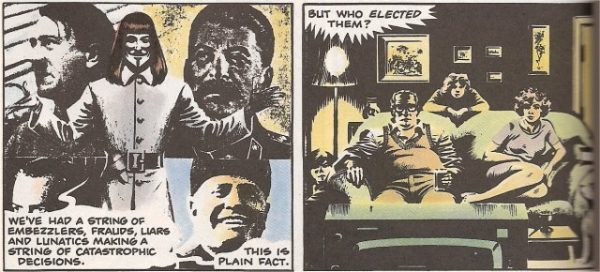NOTE: If you want to receive Five Things, aka As in Guillotine | The Newsletter, via email, sign up at Substack or LinkedIn. Or, go old school and add the RSS feed your favorite reader.
_ONE
Social media is doomed to die | Ellis Hamburger
I’ve spent a lot of time blaming founders for changing their products at the whims of advertisers, but to any social platform’s credit, the users do indeed do it to themselves. In our own eternal quests for social validation, we’re out for growth, too! We readily give in to convenient, advertiser-friendly features like Stories, which prioritize broadcasting over simply communicating. We add more and more friends — because it feels good! — until our close friend group has become our audience.
While I don’t share Hamburger’s cautious optimism about some of the newer platforms, I 100% agree with laying equal blame for the increasingly shitty state of social media at users’ feet. As the saying goes, if you’re not paying, you’re the product, and for as much as people complain about [insert your least favorite “successful” social network here], they’re mostly responding to what users engage with, and feeding them more of it in the most advertiser-friendly and data-mining ways possible.
It’s the next step in Neil Postman’s Amusing Ourselves to Death. From Facebook’s continued dominance to Twitter’s slow-motion decline, it isn’t terribly different from “liberal” politicians and pundits appearing on, and legitimizing, FOX News.
“Be the change you want to see” is frequently employed as a hollow political slogan, but when it comes to social media, we’re way more in control than we want to admit.

__TWO
Notebook: A Notebook on Notes | Ann Kjellberg
Writers cannot truly thrive—practically, or morally and intellectually—on an audience of only themselves; more crucially, a world in which writers are only speaking to each other is an under-informed world. (A little like the world Twitter gave us, to be honest.)
Kjellberg offers a clear-eyed take on Substack’s fledgling Twitter-wannabe and, bigger picture, where social media fits for writers in general. (Bonus points for the Jaron Lanier reference!) After a few weeks casually checking out Notes and sporadically engaging there, the Home Feed is the worst combination of Twitter and LinkedIn, including the occasional amplifying of trolls because we’ve clearly learned nothing over the past 10 years.
One thing I do like about Notes is the “My Subscribers” tab, which lets you see Notes from people who subscribe to your newsletter, even if you don’t subscribe to theirs. Some very interesting people apparently get this newsletter, many of whom I don’t know anything about, so it’s been interesting to meet some of y’all that way.
NOTE: I can’t possibly subscribe to everyone’s newsletter so please don’t take offense! If you’re doing that Team Follow Back thing, though, feel free to unsubscribe because I’ve never played that game.
From tapping its “community” for investment to its CEO’s terrible response to recurring questions about moderation, or lack thereof, Substack is in an increasingly weird space right now. If you can’t give a clear answer to whether or not you’ll tolerate hate speech, you’re basically running a Nazi bar, and I’d rather not hang out in Nazi bars.
As I mentioned when I first moved this newsletter to Substack late last year, everything we do on the internet requires a variety of compromises, but I’m starting to explore alternatives (again), just in case being there becomes intolerable.
___THREE
Why views aren’t everything: The danger of scale metrics in B2B content marketing | Krystle Kopacz
It’s a signal that your strategy is working. It’s a sign that people in your audience want to consume your content and find it really important. Actually, in B2B content marketing it might not be any of those things. It just feels like it is, and that is dangerous.
Chasing scale is often assumed to be every marketer’s goal, but the vast majority of companies have relatively small audiences who have any need for, or interest in, what they’re selling. There are tons of examples where going “viral” did nothing for sales, popular “influencers” who launched products that flopped, and “best-selling” authors barely making enough to pay the rent.
While this article isn’t specifically about social media, it’s a perfect explanation for why many B2B companies, in particular, are still wasting their time on Twitter. It’s easier than doing the hard work of figuring out how to engage your audience in meaningful ways that actually drive conversion because the wrong metrics can lull you into prioritizing the wrong activities.
It’s applicable to many consumer marketers, too, particularly those with the ability to actually influence behaviors rather than simply broadcast their wares and hope the right people are listening.
____FOUR
Cartoon Networking: A New Cartoonist Cooperative is the Latest Group of Creators to Seek Strength in Numbers | Zach Rabiroff
In recent years, both Webtoon and rival web-based publisher Tapas have drawn attention and controversy for the often untenable schedules and low pay rates imposed on creators. De Campi described both web publishers as, “the digital equivalent of the low page rate, IP farming, ‘creator owned’ deals offered by Vault, AWA, Boom, TKO, AfterShock, etc.”
The Cartoonist Cooperative is the least interesting part of this somewhat meandering look at the state of the comics industry from a creator’s perspective, but there’s some good bits throughout. Not surprisingly, Alex de Campi is the clearest voice in the mix, and her broad experience and candor would have made for a much more compelling and actionable story.
(NOTE: I interviewed de Campi back in 2011 and have had the fortune of working with her on a few events over the years since. She’s one of my favorite people in the industry.)
Like publishing itself, comics aren’t one monolithic industry; it’s made up of several overlapping mini-industries, with publishers of all sizes and creators of varied goals.
In theory, I like the idea of co-ops and collectives (Book View Café was one of my favorite examples for years), but The Cartoonist Cooperative is probably going to hit rough waters early on because their ambitions appear to greatly exceed their understanding of how the industry works, what a publisher does and doesn’t do, and what it takes to scale up a functional collective.
_____FIVE
GM killed the Chevy Bolt — and the dream of a small, affordable EV | Dan Seifert
This was a brand-new EV for a total cost well under $30,000. There’s literally nothing quite like it on the road, and it’s a shame that GM has decided it no longer has a future.
In one of the weirder lead generation efforts I’ve ever seen, the Chevy Bolt EV was the least impressive EV I rode in at the NY Auto Show this year — just three weeks ago! — and I’m surprised they featured it at all when it was this close to being killed off and they had their newer EVs on display upstairs.
It seemed like a decent entry level option, with all of the car-related caveats that come with that, particularly suited for warmer, battery-friendly climates like California. (The Chevy driver we had was from New England, egregiously unimpressed with the car, and seemingly offended he had to drive it at all.) It was apparently selling reasonably well, but they’re killing it without a direct replacement anyway because Americans love big trucks?!?!
I’ve said it before, but I’m thinking the shift to EVs isn’t the climate-friendly solution it’s being marketed, sold, and subsidized as.
Do you like email?
Sign up here to get my bi-weekly "newsletter" and/or receive every new blog post delivered right to your inbox. (Burner emails are fine. I get it!)


This piece by Miles O’Brian for PBS News Hour this week is a good watch. It gave me pause as we ponder moving from hybrid to all-electric.
And here is that link. https://www.pbs.org/newshour/show/demand-for-electric-vehicles-growing-but-can-charging-network-keep-up
“People want them more than the system can support them.”
This might be one of the least encouraging things I’ve seen about EVs so far. If it’s this bad in California, I don’t see how EVs hit the aggressive milestones many states are setting w/o equally aggressive infrastructure investments at the federal level. Making the cars “cheaper” isn’t enough.